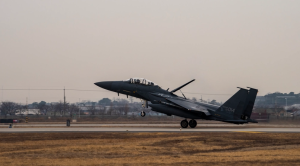South Korea’s “Three Axis” deterrence system is in trouble. North Korea’s recent claim to have tested a new undersea nuclear delivery system is the latest in a long series of developments that throw the credibility of this concept into question. The growing diversity, sophistication, and survivability of the North’s nuclear arsenal undermines the elements of the Three Axis system that rely on deterrence by denial, including preemptive strike and missile defense capabilities. To respond to these developments, Seoul should focus its efforts on deterrence by punishment, bolstering its retaliatory capabilities in order to dissuade Pyongyang from aggression.
South Korea’s plan to deter a North Korean attack revolves around the “Three Axis” system. This system ties together three military concepts. The first concept, commonly known as the “Kill Chain,” seeks to use advanced detection, targeting, and long-range strike capabilities to enable South Korea to preemptively destroy an imminent North Korean missile launch. The second concept, labeled “Korean Air and Missile Defense” (KAMD), employs ballistic missile defense systems to allow South Korea to shoot down North Korean missiles in-flight. The final concept, “Korean Massive Punishment and Retaliation” (KMPR), emphasizes the use of special operations forces and a diverse array of strike capabilities to deliver a debilitating retaliatory blow in the aftermath of a North Korean attack.
The Kill Chain and KAMD concepts hinge on deterrence by denial. They aim to dissuade North Korea from aggression by limiting its ability to successfully strike South Korea with nuclear-armed missiles. KMPR, on the other hand, relies on a different approach: deterrence by punishment. It seeks to convince North Korea that a strategic attack on the South, even if initially successful, would prompt an overwhelming punitive response from South Korea.
North Korea’s pursuit of a growing range of advanced nuclear delivery-systems threatens to hamstring South Korea’s efforts at deterrence by denial. The Kill Chain looks less and less credible as the North tests systems that improve the mobility and survivability of its nuclear delivery systems. Pyongyang has successfully tested the ability to launch ballistic and cruise missiles from submarines, which would be difficult for South Korea to track and preemptively eliminate. If North Korea fulfills its stated ambition of fielding a nuclear-propelled missile submarine, this would further strain the South’s ability to detect and disrupt an imminent launch. Similarly, Pyongyang has developed rail-mobile and road-mobile launchers as well as underwater silos, which would make it even more challenging for the South to pinpoint and eliminate the North’s missiles.
Unfortunately, North Korea’s growing military capabilities also degrade the reliability of KAMD. The North has tested several hypersonic delivery vehicles, which are exceptionally difficult to intercept due to their speed and maneuverability. Similarly, Pyongyang has developed new short-range ballistic missiles capable of flying at a depressed trajectory to hamper detection by missile defense systems. Most recently, North Korea claims to have successfully tested an undersea drone capable of delivering a nuclear warhead against a coastal target. Such a capability would circumvent South Korea’s existing missile defense systems, which are designed to defend against ballistic missiles.
All of these emerging capabilities make it much more challenging for South Korea to deter Pyongyang through denial. They do not, however, limit Seoul’s ability to retaliate in the event of a North Korean attack. Sophisticated nuclear delivery systems do little to shield North Korea’s leaders and military headquarters from a South Korean counterstrike.
As such, the South should make KMPR the centerpiece of its “Three-Axis” system. While Kill Chain and KAMD have their merits, KMPR’s effectiveness is not diminished by North Korea’s rapidly-advancing nuclear capabilities. The bulk of Seoul’s resources, as such, should be dedicated to strengthening air, sea, and land-based strike options against a wide-spectrum of North Korean political, military, and economic targets.
South Korea must be careful to ensure that these retaliatory capabilities are survivable. Its development of submarine-launched missiles is an important step in this direction, as are its efforts to harden South Korean air bases. Furthermore, the South should ensure that it has stockpiled sufficient quantities of the relevant munitions. Seoul should also take advantage of renewed momentum in its relationship with Japan to discuss how Japan’s planned “counterstrike” capability could be coordinated with KMPR. Finally, South Korea should maintain a strong partnership with its ally, the United States, and look for opportunities to shore up the credibility of the U.S. extended deterrent.
These steps will help ensure South Korea’s continued security in the Pyongyang’s continued nuclear proliferation.

































